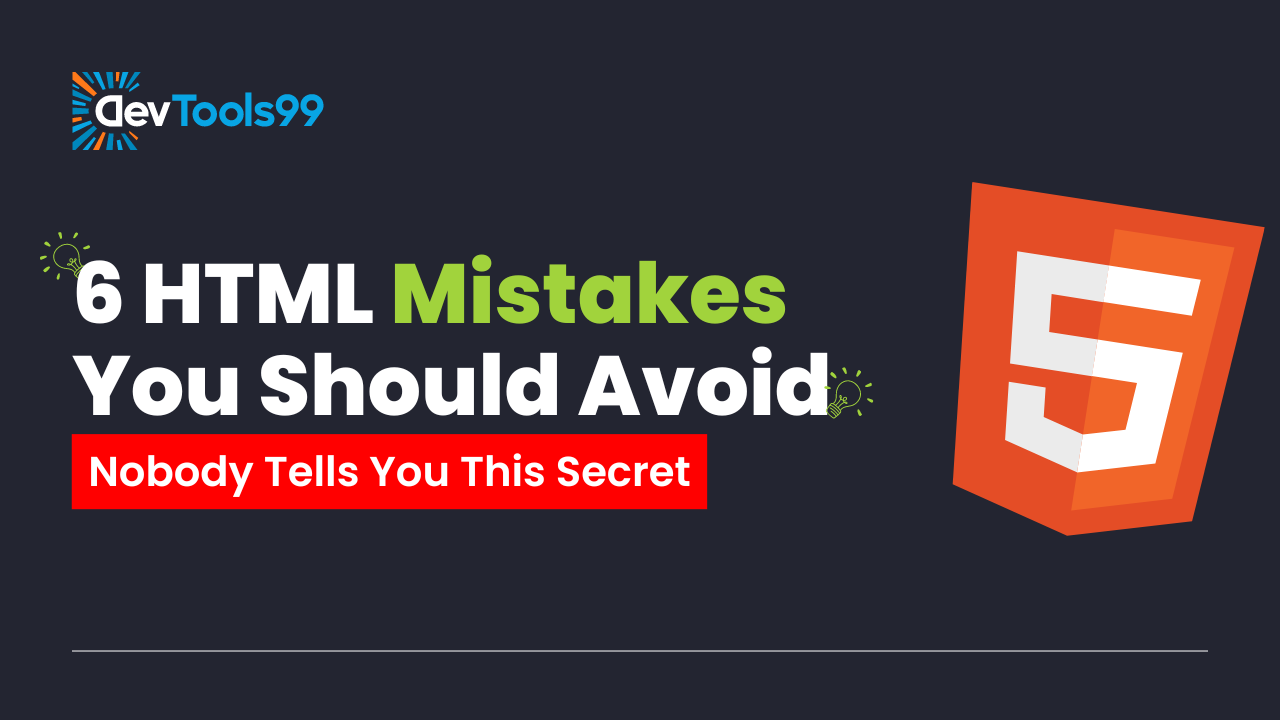
6 HTML Mistakes You Should Avoid
HTML is the foundation of every website, and writing it properly can ensure that your site is functional, accessible, and SEO-friendly. However, there are several common mistakes that developers often make when writing HTML. In this post, we’ll go over six of these mistakes, explain why they matter, and provide guidance on how to avoid them.
1. Not Closing Tags
HTML has both self-closing tags (like <img> and <input>) and non-self-closing tags (like <div> and <p>). While self-closing tags don’t require a closing counterpart, non-self-closing tags do. Failing to close non-self-closing tags can lead to unexpected rendering issues in the browser. Although modern browsers are capable of fixing these errors automatically, this is not a reliable solution. Not closing tags can break your website’s layout, especially when viewed on different devices or browsers.
Why This Is Important: Inconsistent tag handling can cause accessibility tools like screen readers to misinterpret content and can disrupt the browser’s understanding of the document structure. By ensuring all tags are properly closed, you maintain clean, well-structured, and functional code across different platforms.
2. Not Writing the alt Attribute
The alt attribute is a crucial part of writing good HTML, especially when it comes to images. This attribute provides alternative text that can be read aloud by screen readers, helping visually impaired users understand what an image is depicting. Furthermore, the alt attribute is used by search engines to better understand the content of an image. Images without alt attributes are less likely to rank in search results, which can hurt your website’s SEO.
Why This Is Important: Accessibility and SEO go hand in hand. Adding a descriptive alt attribute ensures that everyone, including those using assistive technologies, can access your content. Additionally, it helps search engines properly index your images, improving your site’s visibility in image search results. Failing to include alt text may lead to missed opportunities for ranking and can prevent your website from being fully accessible.
3. Missing Doctype
The <!DOCTYPE html> declaration is the first line of every HTML document and indicates the HTML version that is being used. Without this declaration, browsers may enter “quirks mode,” which can cause them to render pages differently than expected. Quirks mode is especially problematic for older browsers, where rendering issues are more common.
Why This Is Important: Including the doctype ensures that your page renders correctly across all browsers. It tells the browser that you are using HTML5 (or whichever version of HTML you declare), which helps it process the page according to modern standards. By failing to declare the doctype, you open the door to inconsistencies, broken layouts, and potential issues with older or less popular browsers.
4. Using Inline Styles
Inline styles refer to applying CSS styles directly within an HTML element using the style attribute. While inline styles are sometimes convenient for small, quick adjustments, they are not a best practice for building scalable websites. Using inline styles mixes HTML and CSS, making it more difficult to maintain and update the website in the future. A more efficient approach is to separate the structure (HTML) from the styling (CSS) by using external or internal style sheets.
Why This Is Important: Maintaining a clean separation between HTML and CSS makes your website easier to manage, especially as it grows. If styles are scattered across many elements using inline styles, updates become tedious and error-prone. External style sheets provide a centralized location where changes can be made globally, improving both the maintainability and scalability of the project.
5. Block Elements Inside Inline Elements
Block elements, such as <div> and <p>, are intended to occupy the entire width of their parent container, and they start on a new line. Inline elements, like <span> and <a>, only take up as much space as they need within a line of text. Nesting block elements inside inline elements is not valid HTML and can result in broken layouts and unexpected rendering issues.
Why This Is Important: Properly nesting elements ensures that your layout will display consistently across all browsers. Incorrectly placing block elements within inline elements can cause display issues and make your site harder to debug. By following proper nesting rules, you create a more reliable and maintainable structure for your web pages.
6. Using <b> and <i> Instead of <strong> and <em>
The <b> and <i> tags are used to make text bold and italic, respectively. However, they don’t carry any semantic meaning. Instead, you should use <strong> and <em>, which not only provide the same visual effect (bold and italic text), but also convey meaning to screen readers and search engines. <strong> indicates that text is important, while <em> adds emphasis.
Why This Is Important: Semantic HTML improves accessibility and SEO. Screen readers recognize <strong> and <em> as meaningful, which helps users better understand the context and importance of the text. Search engines also give weight to semantic tags, which can help improve your page’s SEO. By using these tags correctly, you make your content more accessible and valuable to both users and search engines.
Conclusion
By avoiding these common mistakes, you’ll ensure that your HTML is clean, maintainable, and accessible. Whether it’s closing your tags properly, using semantic HTML, or avoiding inline styles, following best practices helps your website perform better for both users and search engines. Remember, attention to detail in your code will pay off in the long run by improving your site's user experience and search engine rankings.
Follow Us:
Stay updated with our latest tips and tutorials by subscribing to our YouTube Channel.
